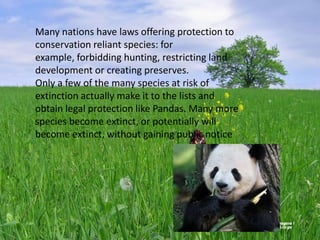Animals in danger
- 1. -Endangered animals are those species that are in danger of going extinct. Their reproductive rates are lower than their mortality rates over long periods of time, so their numbers are diminishing. The reasons for this are varied, but lately, very often involves a loss of habitat as people encroach on their living areas. -When a species is listed as endangered or threatened, it is not a death sentence. Many animals, like the bald eagle and the American alligator, were on the brink of extinction and are now recovering. Many species, however, will not recover, and could be lost forever. -Throughout time, animal species have been going extinct (long before people evolved); paleontologists estimate that well over 90 percent of all plant and animal species that ever existed have gone extinct.
- 2. The Siberian Tiger is a subspecies of tiger that is critically endangered; three subspecies of tiger are already extinct. The most endangered Asiatic top predator, the dhole is on the edge of extinction.
- 3. Endangered Birds list This species qualifies as Critically Endangered because it occurs on one extremely small island and undergoes marked fluctuations in population, owing to climatic events, reducing it to tiny numbers. The accidental introduction of mammalian predators, non- native pest plants or insect species could rapidly bring about its extinction.
- 4. This species has an extremely small range confined to mixed tree-fern forest on one small island, where recent surveys have shown it to have an extremely small population which may be declining. It is therefore listed as Critically Endangered.
- 5. This crow has recently been rediscovered and is listed as Critically Endangered because it is estimated to have a very small population, with the majority of individuals in a single subpopulation, and undergoing a continuing decline owing primarily to on-going habitat loss. Following further surveys, the species's status may need to be re-evaluated
- 6. Vietnam is home to around 10% of the world's species. 5 of the 25 most endangered primates are endemic to Vietnam, but wildlife in Vietnam has become very scarce. Responsible are habitat loss by deforestation and the flourishing trade of wild animals and their meat or parts for traditional medicine and food in Asia. WAGI is supporting law-enforcement and ranger work in Nature Reserves of Vietnam's Thanh Hoa province providing financial assistance for effective anti-poaching patrols and by contributing towards animal rescue costs.
- 7. Many nations have laws offering protection to conservation reliant species: for example, forbidding hunting, restricting land development or creating preserves. Only a few of the many species at risk of extinction actually make it to the lists and obtain legal protection like Pandas. Many more species become extinct, or potentially will become extinct, without gaining public notice








